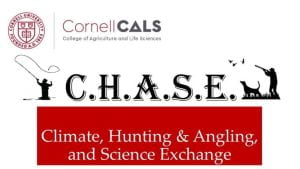
In North America, hunters and anglers are significant contributors to federal and state conservation budgets via excise taxes. Yet hunters and anglers are generally likely to be more politically conservative and therefore less likely to be persuaded by arguments regarding climate change and negative effects on habitats and quarry. Understanding beliefs, attitudes, and motivations regarding climate change among hunters and anglers is a key to future conservation efforts and conservation funding.
While climate science becomes increasingly more accessible, the climate change discourse becomes evermore polarized. Given the relatively conservative political views of many hunters and anglers, where do hunters and anglers turn for information about climate change that is relevant to their hobbies and passions? Would hunters and anglers utilize an information clearinghouse and library on hunting/fishing/trapping relevant climate change content? The Climate, Hunters & Anglers, and Science Exchange (C.H.A.S.E.) serves as a platform for answering these and other related questions.
Peer-Reviewed Scientific Articles
Climate, Hunting and Game species
Mammals
Huntington, H. P., et al. (2017). Evaluating the Effects of Climate Change on Indigenous Marine Mammal Hunting in Northern and Western Alaska Using Traditional Knowledge. Frontiers in Marine Science, 4(319). https://doi.org/10.3389/fmars.2017.00319.
Weiskopf, S.R., Ledee, O.E. and Thompson, L.M. (2019). Climate change effects on deer and moose in the Midwest. Journal of Wildlife Management, 83(4), 769-781. https://doi.org/10.1002/jwmg.21649.
Rettler, S.J., et al. (2021). Three decades of declining natural foods alters bottom-up pressures on American black bears. Forest Ecology and Management, 493, 119267. https://doi.org/10.1016/j.foreco.2021.119267.
Birds
Kozma, R., Melsted, P., Magnússon, K.P. and Höglund, J. (2016). Looking into the past – the reaction of three grouse species to climate change over the last million years using whole genome sequences. Molecular Ecology, 25(2), 570-580. https://doi.org/10.1111/mec.13496.
Creutzburg, M., Henderson E., Conklin, D. (2015). Climate change and land management impact rangeland condition and sage-grouse habitat in southeastern Oregon. AIMS Environmental Science, 2(2), 203-236. https://doi.org/10.3934/environsci.2015.2.203.
Hovick, T. J., R. D. Elmore, B. W. Allred, S. D. Fuhlendorf, and D. K. Dahlgren. (2014). Landscapes as a moderator of thermal extremes: a case study from an imperiled grouse. Ecosphere, 5(3), 1-12. https://doi.org/10.1890/ES13-00340.1.
Jennifer Sorensen Forbey, Natasha L. Wiggins, Graham G. Frye, John W. Connelly. (2013). Hungry grouse in a warming world: emerging risks from plant chemical defenses and climate change. Wildlife Biology, 19(4), 374-381. https://doi.org/10.2981/13-014.
Selås, V., Sonerud, G.A., Framstad, E. et al. (2011). Climate change in Norway: warm summers limit grouse reproduction. Population Ecology, 53(2), 361–371. https://doi.org/10.1007/s10144-010-0255-0.
Schrag, A., Konrad, S., Miller, S. et al. (2011). Climate-change impacts on sagebrush habitat and West Nile virus transmission risk and conservation implications for greater sage-grouse. GeoJournal, 76(5), 561–575. https://doi.org/10.1007/s10708-010-9369-3.
Climate, Fishing & Game Species
Freshwater
Jane, S.F. et al. (2024). Concurrent warming and browning eliminate cold-water fish habitat in many temperate lakes. Proceedings of the National Academy of Science, 121 (2). https://doi.org/10.1073/pnas.23069061
Wenger, S. J., et al. (2011). “Flow regime, temperature, and biotic interactions drive differential declines of trout species under climate change.” Proceedings of the National Academy of Sciences 108(34): 14175-14180.
Wenger, S. J., et al. (2011). Role of climate and invasive species in structuring trout distributions in the interior Columbia River Basin, USA. Canadian Journal of Fisheries and Aquatic Sciences, 68(6), 988-1008. https://doi.org/10.1139/f2011-034.
Ficke, A. D., et al. (2007). “Potential impacts of global climate change on freshwater fisheries.” Reviews in Fish Biology and Fisheries, 17(4): 581-613.
Battin, J.; Wiley, M. W.; Ruckelshaus, M. H.; Palmer, R.N.; Korb, E.; Bartz, K.K.; Imaki, H. (2007). Projected impacts of climate change on salmon habitat restoration. Proceedings of the National Academy of Science, 104(16), 6720-6725. https://doi.org/10.1073/pnas.0701685104.
Crozier, L. G.; Zabel, R. W. (2006). Climate impacts at multiple scales: evidence for differential population responses in juvenile Chinook salmon. Journal of Animal Ecology, 75(5), 1100-1109. https://doi.org/10.1111/j.1365-2656.2006.01130.x.
Mote, P. W., Parson, E. A., Hamlet, A. F., et al. (2003). Preparing for climatic change: the water, salmon, and forests of the Pacific Northwest. Climatic Change, 61, 45-88. https://doi.org/10.1023/A:1026302914358.
Mantua, N. J.; Hare, S. R.; Zhang, Y.; Wallace, J. M.; Francis, R. C. (1997). A Pacific interdecadal climate oscillation with impacts on salmon production. Bulletin of the American Meteorological Society, 78, 1069-1079. https://doi.org/10.1175/1520-0477(1997)078<1069:APICOW>2.0.CO;2.
Jones, R., Travers, C., Rodgers, C., et al. (2012). Climate change impacts on freshwater recreational fishing in the United States. Mitigation and Adaptation Strategies for Global Change,18, 731–758. https://doi.org/10.1007/s11027-012-9385-3.
Williams, J. E., Haak, A. L., Neville, H. M., Colyer, W. T. (2009). Potential Consequences of Climate Change to Persistence of Cutthroat Trout Populations. North American Journal of Fisheries Management, 29(3), 533-548. https://doi.org/10.1577/M08-072.1.
Hunt, L. M., et al. (2016). Identifying Alternate Pathways for Climate Change to Impact Inland Recreational Fishers. Fisheries, Special Issue: Climate Change 41(7), 362-372. https://doi.org/10.1080/03632415.2016.1187015.
Saltwater
Rogers, L. A., et al. (2019). Shifting habitats expose fishing communities to risk under climate change. Nature Climate Change, 9(7), 512–516. https://doi.org/10.1038/s41558-019-0503-z.
Townhill, B. L., et al. (2019). Marine recreational fishing and the implications of climate change. Fish and Fisheries, 20(5), 977-992. https://doi.org/10.1111/faf.12392.
Steven J. Dundas, Roger H. von Haefen. (2015). Weather Effects on the Demand for Coastal Recreational Fishing: Implications for a Changing Climate. Center for Environmental and Resource Economic Policy. https://www.jstor.org/stable/resrep37132.
Climate, Hunter & Angler Beliefs & Motivations
Love-Nichols, J. (2020). Tied to the Land”: Climate Change Activism Among U.S. Hunters and Fishers. Frontiers in Communication, 5(1). https://doi.org/10.3389/fcomm.2020.00001.
Hestetune, A., et al. (2020). Climate change and angling behavior on the North shore of Lake Superior (USA). Fisheries Research 231, 105717. https://doi.org/10.1016/j.fishres.2020.105717.
(2015). Translating Climate Change Effects into Everyday Language: An Example of More Driving and Less Angling. Fisheries, 40(8), 395-398. https://fisheries.org/2015/07/translating-climate-change-effects-into-everyday-language-an-example-of-more-driving-and-less-angling/.
Nyboer, E. A., et al. (2021). Global assessment of marine and freshwater recreational fish reveals mismatch in climate change vulnerability and conservation effort. Global Change Biology, 27(19), 4799-4824. https://doi.org/10.1111/gcb.15768.
Cooperative Extension Publications
Rines, K. New Hampshire’s Moose Population vs Climate Change.
Popular Press and Media Publications
Wang, Esther. (2024) On Thin Ice: Can ice fishing—and coldwater fish like trout—survive in a warming New York? HellGate.